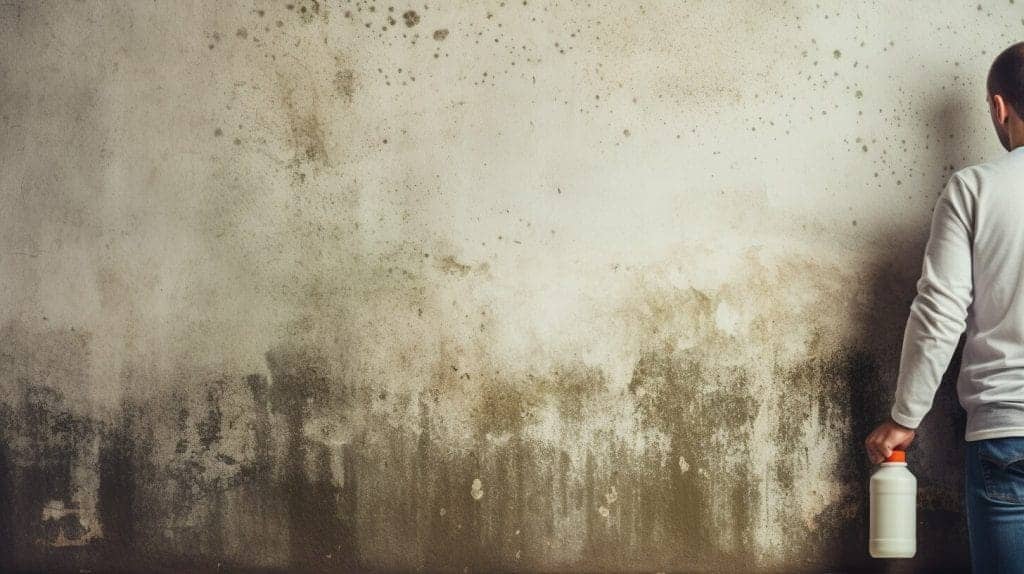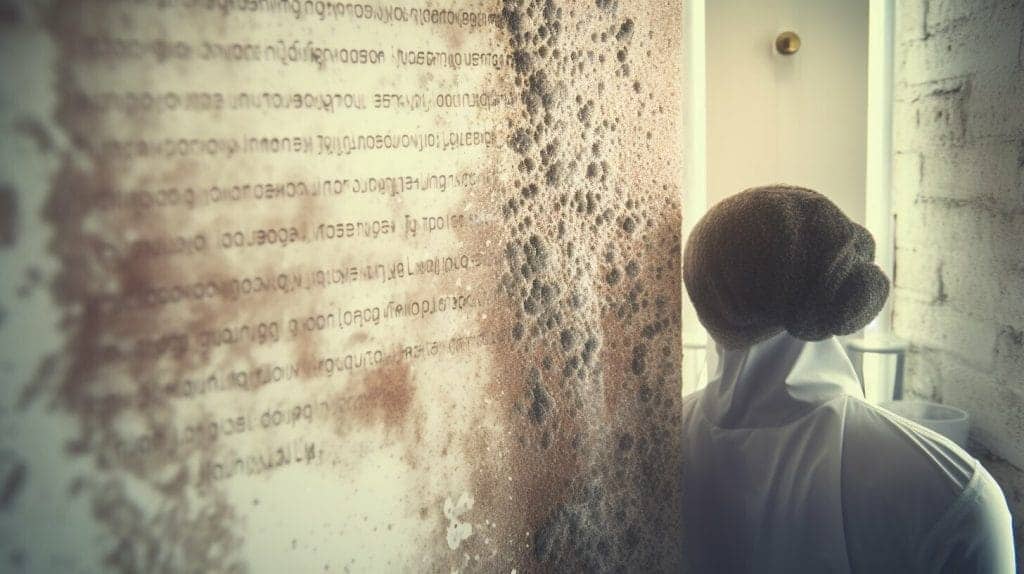Welcome to our guide on toxic mold and its distinctive scent. Mold growth is a common problem in many homes, often causing unpleasant odors and potentially hazardous health effects. In this article, we will explore the question of what does toxic mold smell like and the dangers associated with it. By understanding the different types of mold smells and how to detect them, you can effectively protect your home and your loved ones from the harmful effects of toxic mold.
Identifying Mold Smells
If you’ve ever experienced a musty odor in your home or workplace, it’s likely that you’re smelling mold. Mold produces a distinctive, earthy scent that can be easily recognized with a little bit of practice. But how do you know if the smell you’re experiencing is from toxic mold or a harmless type of mold? Let’s explore some of the identifying factors.
Recognizing Mold Scent
The first step to identifying mold smell is to learn how to recognize mold scent. As mentioned earlier, mold produces a musty, earthy smell that is often described as damp or stale. But not all types of mold smell the same. In fact, different types of mold produce different scents, so it’s important to familiarize yourself with the most common ones.
Harmless types of mold, such as Cladosporium or Penicillium, produce a musty odor, but the scent is typically less intense than that of toxic mold. On the other hand, toxic molds like Stachybotrys or Aspergillus produce a much stronger, more pungent odor that can be overpowering.
Types of Odors Produced by Mold
Mold can produce a variety of odors, depending on the type and severity of the mold growth. Some of the common odors produced by mold include:
| Mold Odor | Mold Type |
|---|---|
| Musty | Cladosporium, Penicillium |
| Foul | Aspergillus, Chaetomium, Fusarium |
| Earthy | Actinomycetes, Streptomyces, Nocardia |
| Sour | Acremonium |
| Sweet | Aureobasidium, Ulocladium |
As you can see, some types of mold produce more unpleasant smells than others. If you’re experiencing an intense, foul odor in your home or workplace, it’s important to take it seriously and investigate the source. Toxic mold can pose serious health risks, so it’s always better to err on the side of caution.
Signs of Toxic Mold Growth
Identifying mold growth in your home can be a challenging task, especially since it can grow in hidden areas like behind walls and under carpets, or in areas with poor ventilation and high humidity. Here are some signs to look out for when trying to identify toxic mold growth:
| Signs of Toxic Mold Growth | Description |
|---|---|
| Visible Growth | One of the most obvious signs of mold growth is visible spots or patches on surfaces, which can be black, green, white, or other colors. |
| Musty Odor | The musty odor associated with mold is a strong indicator that there may be mold growth in your home. This smell can be particularly strong in areas with poor ventilation or high humidity. |
| Water Damage | Mold thrives in damp environments, so water damage or moisture problems in your home can often lead to mold growth. Look for any signs of leaks, flooding, or water stains on walls or ceilings. |
| Health Symptoms | Exposure to toxic mold can cause a range of health symptoms, including respiratory issues, allergies, skin irritation, headaches, and fatigue. If you or members of your family are experiencing these symptoms, it may be a sign of toxic mold growth in your home. |
If you notice any of these signs, it’s important to take action as soon as possible to prevent further mold growth and potential health hazards.
Musty Odor and Toxic Molds
One of the most common associations with mold is the musty odor that many people notice. This smell is often an indication of mold growth, although not all types of mold produce a musty odor. In the case of toxic molds, however, the presence of a musty smell can be an indication of a potential health hazard.
Musty odors are typically created by a group of chemicals known as microbial volatile organic compounds (mVOCs). These compounds are released when mold metabolizes and can produce a strong, unpleasant odor. In some cases, the smell can be so strong that it becomes overwhelming and can cause headaches, dizziness, and other symptoms.
While a musty odor does not necessarily indicate that toxic mold is present, it is important to take any such odors seriously and investigate their source. In the case of toxic molds, seeking professional remediation is often necessary in order to mitigate the health risks posed by these compounds.
Health Effects of Mold Smell
Exposure to mold can have a variety of negative health effects. Some people may experience symptoms immediately, while others may not experience any symptoms for several days or even weeks. It’s important to understand the potential health hazards associated with mold smell and take action to prevent and combat its growth.
Allergies
One of the most common health effects of mold smell is allergies. Exposure to mold can cause nasal congestion, sneezing, itching, and other allergy symptoms. Individuals with allergies or asthma may be especially sensitive to mold and experience more severe symptoms.
Respiratory Issues
In addition to allergies, mold smell can also cause respiratory issues. Exposure to mold can irritate the lungs and lead to coughing, wheezing, and difficulty breathing. Long-term exposure to mold can also increase the risk of developing respiratory infections.
Other Health Effects
Mold smell has also been linked to a variety of other health effects, including headaches, dizziness, and fatigue. In some cases, exposure to toxic molds can even lead to more serious health issues, such as neurological damage and cancer.
If you suspect that you have been exposed to mold, it’s important to seek medical attention if you experience any symptoms. Additionally, taking steps to prevent and combat mold growth can help protect your health and the health of those around you.
How to Detect Mold through Smell
If you suspect that your home or workplace has a mold problem, one way to confirm your suspicion is through the sense of smell. Below are some tips on how to properly detect mold through smell:
Step 1: Follow Your Nose
The first step in detecting mold through smell is to follow your nose. Start at the source of any musty, earthy odors and work your way outward. Trust your senses and investigate any areas where you suspect mold growth.
Step 2: Check Common Mold Prone Areas
Common mold growth areas include bathrooms, kitchens, laundry rooms, and basements. Check these areas for any signs of visible mold growth or excess moisture or water damage, as this can often lead to mold growth.
Step 3: Don’t Forget Less Obvious Areas
Mold can grow in less obvious areas, such as walls, insulation, and air ducts. Check these areas as well if you suspect mold growth.
Step 4: Identify the Smell
Once you’ve followed your nose to the source of the odor, try to identify the smell. Does it have a musty, earthy odor, or is it more pungent and unpleasant? This can help you determine whether the mold is toxic or not.
Step 5: Call a Professional
If you suspect you have toxic mold in your home or workplace, it’s important to call a professional for proper identification and remediation. Attempting to remove the mold yourself can be dangerous and lead to further contamination.
By following these tips, you can effectively detect mold through smell and take the necessary steps to protect your health and property.
Recognizing Mold Scent
Recognizing mold scent can be challenging, especially given that different types of mold can produce different smells. However, there are some general characteristics that can help you identify the presence of mold in your home or workplace.
Musty Odor
The most common indicator of mold is a musty odor. This smell is often described as similar to that of wet socks or rotten wood, and is caused by the metabolic byproducts of mold growth. If you notice an unusual odor in your home or office, it is important to investigate the cause and take steps to address it, as it may be a sign of toxic mold growth.
Other Smells
In addition to the musty smell, mold can also produce other smells depending on the type of mold present. For example, some molds can produce a foul or pungent odor, while others may have a sweet or fruity scent. Some people describe the smell of mold as earthy or damp.
Identifying the Smell
To identify the smell of mold, it is important to use your sense of smell. Walk through your home or workplace and take note of any unusual odors. Pay attention to areas where water damage or moisture issues have occurred, as these are prime locations for mold growth. If you suspect you may have a mold problem, you can also hire a professional to conduct a mold inspection.
Understanding the Odor of Toxic Mold
The odor of toxic mold can often be described as strong, pungent, and musty. It can resemble the scent of damp earth or rotting wood, but with a distinct, unpleasant edge that is difficult to ignore. This odor is caused by volatile organic compounds or VOCs, which are released as toxic mold grows and thrives.
VOCs are a group of chemicals that are known to have a range of negative health effects, including eye and respiratory irritation, headaches, and nausea. Prolonged exposure to VOCs can also lead to more serious health issues, such as liver and kidney damage, and even cancer.
Compounds Responsible for Mold Odor
There are several compounds responsible for the distinctive odor of toxic mold. The most common compounds found in mold are:
| Compound Name | Odor Description |
|---|---|
| Geosmin | Earthy, musty odor |
| MVOCs | Various odors, often described as pungent or unpleasant |
| Benzaldehyde | Sweet, almond-like odor |
While these compounds themselves don’t necessarily pose a direct threat to human health, their presence in the air can indicate the presence of toxic mold, which can have serious health consequences.
It’s important to note that not all mold produces VOCs, and not all VOCs are produced by toxic molds. However, the presence of a strong, musty odor is often a strong indication of toxic mold growth.
Types of Toxic Molds
There are various types of toxic molds that can have a significant impact on human health. The most common species include:
| Mold | Health Risks | Symptoms |
|---|---|---|
| Stachybotrys chartarum (black mold) | Respiratory issues, memory loss, fatigue, mood swings | Headaches, difficulty concentrating, dizziness, nausea |
| Aspergillus | Respiratory infections, allergic reactions, lung inflammation | Wheezing, coughing, chest tightness, fever |
| Penicillium | Lung inflammation, allergic reactions, respiratory infections | Wheezing, coughing, chest tightness, fever |
It’s important to note that the symptoms may vary depending on the individual’s sensitivity and exposure level to the mold, as well as the type of mold present.
Preventing Toxic Mold Growth
Mold can be a persistent problem once it takes hold, so it’s essential to take preventative measures to keep it from growing in the first place. Here are some tips to help you prevent the growth of toxic mold:
- Use a dehumidifier: Mold thrives in moist environments, so it’s essential to keep the air in your home dry. Using a dehumidifier can help prevent excess moisture buildup and keep mold from growing.
- Fix leaks promptly: Leaks in pipes, roofs, and windows can all contribute to mold growth. Address any leaks as soon as possible to prevent water from seeping into your home and causing mold growth.
- Keep your home well-ventilated: Proper ventilation can help prevent mold growth by allowing moisture to escape. Make sure that your home has sufficient ventilation in high-humidity areas like bathrooms and kitchens.
- Clean up spills and messes quickly: If you spill something or make a mess, clean it up promptly. Leaving spills and messes to sit can create a moist environment that’s perfect for mold growth.
- Clean and maintain HVAC systems: Mold can thrive in HVAC systems, so it’s essential to have them cleaned and maintained regularly to prevent mold growth.
- Regularly inspect your home: Keep an eye out for any signs of mold growth, such as musty odors or discoloration on walls or ceilings. If you detect mold growth, act quickly to address it before it spreads.
By taking these preventative measures, you can help keep your home mold-free and prevent the potential health hazards associated with toxic mold exposure.
How to Combat Toxic Mold
If you have discovered toxic mold in your home or workplace, it is crucial to take immediate action to combat the problem and prevent further health risks and structural damage. Here are some tips on how to effectively combat toxic mold:
1. Identify the source of the problem
The first step in combating toxic mold is to identify the source of the problem. This may involve inspecting for leaks or moisture problems and ensuring proper ventilation in affected areas.
2. Use proper safety gear
When dealing with toxic mold, it is important to use appropriate safety gear, such as gloves, goggles, and a respirator. This will protect you from exposure to harmful mold spores.
3. Remove affected materials
If there are any materials or surfaces affected by mold, such as drywall or carpet, they may need to be removed and replaced. This will prevent further mold growth and eliminate the source of the problem.
4. Clean thoroughly
Once affected materials have been removed, the area must be cleaned thoroughly with bleach or other mold-killing solutions. Make sure to follow all instructions and safety precautions when using these products.
5. Address underlying issues
To prevent future mold growth, it is important to address any underlying issues that may have caused the problem in the first place. This may involve repairing leaks, improving ventilation, or installing a dehumidifier.
6. Seek professional help
If the mold problem is extensive or you are unsure how to address it, it is important to seek professional help from a certified mold remediation company. They will have the expertise and equipment necessary to safely and effectively combat toxic mold.
FAQ
Are you still unsure about what toxic mold smells like and how to deal with it? Here are some commonly asked questions that can help clarify any remaining concerns:
Q: What does toxic mold smell like?
A: Toxic mold can produce a variety of odors, including a musty or earthy smell, a damp or stale odor, or even a strong, unpleasant odor similar to urine or feces. It’s important to note that some molds may not have a noticeable scent, so it’s important to look for other signs of mold growth as well.
Q: Can mold smell make me sick?
A: Yes, exposure to mold smell can cause a range of health problems, including respiratory issues, allergies, and other toxic effects on the body. It’s important to address any mold growth as soon as possible to prevent these health hazards.
Q: How do I detect mold through smell?
A: To detect mold through smell, start by identifying any areas with visible mold growth or moisture problems. Then, take a deep breath and try to detect any musty or earthy odors in the air. You can also use your sense of smell to locate hidden mold growth, such as in walls or carpets.
Q: How can I prevent toxic mold growth?
A: There are several steps you can take to prevent toxic mold growth, including reducing humidity levels in your home, fixing any leaks or water damage promptly, and using proper ventilation in areas like the bathroom and kitchen. Regular cleaning and maintenance can also help prevent mold growth.
Q: Can I remove toxic mold myself?
A: In some cases, small areas of mold growth can be safely removed by the homeowner using appropriate protective gear and cleaning solutions. However, if you have a larger or more severe mold problem, it’s important to seek professional help to ensure safe and effective remediation.
Dr. Francisco Contreras, MD is a renowned integrative medical physician with over 20 years of dedicated experience in the field of integrative medicine. As the Medical Director of the Oasis of Hope Hospital in Tijuana, Mexico, he has pioneered innovative treatments and integrative approaches that have been recognized globally for the treatment of cancer, Lyme Disease, Mold Toxicity, and chronic disease using alternative treatment modalities. Dr. Contreras holds a medical degree from the Autonomous University of Mexico in Toluca, and speciality in surgical oncology from the University of Vienna in Austria.
Under his visionary leadership, the Oasis of Hope Hospital has emerged as a leading institution, renowned for its innovative treatments and patient-centric approach for treating cancer, Lyme Disease, Mold Toxicity, Long-Haul COVID, and chronic disease. The hospital, under Dr. Contreras's guidance, has successfully treated thousands of patients, many of whom traveled from different parts of the world, seeking the unique and compassionate care the institution offers.
Dr. Contreras has contributed to numerous research papers, articles, and medical journals, solidifying his expertise in the realm of integrative medicine. His commitment to patient care and evidence-based treatments has earned him a reputation for trustworthiness and excellence. Dr. Contreras is frequently invited to speak at international conferences and has been featured on CNN, WMAR2 News, KGUN9 News, Tyent USA, and various others for his groundbreaking work. His dedication to the medical community and his patients is unwavering, making him a leading authority in the field.
Contreras has authored and co-authored several books concerning integrative therapy, cancer, Lyme Disease and heart disease prevention and chronic illness, including "The Art Science of Undermining Cancer", "The Art & Science of Undermining Cancer: Strategies to Slow, Control, Reverse", "Look Younger, Live Longer: 10 Steps to Reverse Aging and Live a Vibrant Life", "The Coming Cancer Cure Your Guide to effective alternative, conventional and integrative therapies", "Hope Medicine & Healing", "Health in the 21st Century: Will Doctors Survive?", "Healthy Heart: An alternative guide to a healthy heart", “The Hope of Living Cancer Free”, “Hope Of Living Long And Well: 10 Steps to look younger, feel better, live longer” “Fighting Cancer 20 Different Ways”, "50 Critical Cancer Answers: Your Personal Battle Plan for Beating Cancer", "To Beat . . . Or Not to Beat?", and “Dismantling Cancer.”









